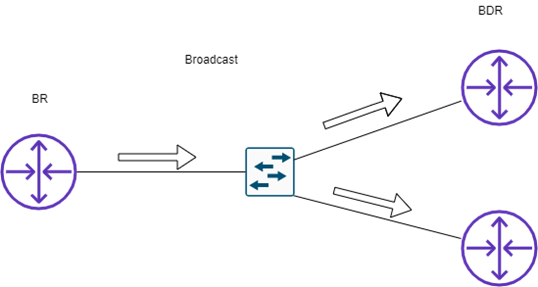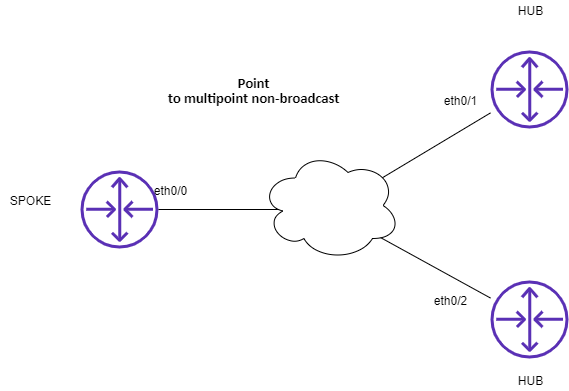OSPF contains how many types of Link State Advertisement in it?
What is LSA?
LSA stands for Link State Advertisement. Each router makes a database table in which it keeps LSA. The router then runs SPF (shortest path first) algorithm on the database table and generates a routing table. In this blog, we will learn about how many types of LSA are present in OSPF.
There are normally seven types of LSA
- type1 LSA (Router LSA)
- type2 LSA (network LSA)
- type3 LSA (summary LSA)
- type4 LSA (ASBR Summary LSA)
- type5 LSA (External LSA)
- type6 LSA (Group Membership LSA)
- type7 LSA (NSSA LSA)
Working of LSA
Router LSA (type1): – Router LSA is generated by every router within an area to represent itself and it will not cross its area. Within the area all routers have common ‘Router LSA’ information, one router LSA can keep having multiple links information, by default router will flood LSA every 30 min. if any router receives a higher sequence number of LSA, then the router will execute the SPF algorithm. Now if I talk about LSA link-id and advertising router-id, it will be the same. And special bits like ‘V’ endpoint of a virtual link, ‘E’ is ASBR, and ‘B’ ABR (Area Border Router). router LSA contains some special bits like ‘V’ endpoint of a virtual link, ‘E’ it is ASBR and ‘B’ it is ABR (Area Border Router).
Network LSA (type2): – network LSA is generated by the DR (Designated Router) router within a segment to represent itself. It is having information that how many devices are connected in that multi-access network segment in the form of router-id. It will also have the information of the DR router’s IP address and send it to all attached routers between the same area.
Summary LSA (type3): – it is generated by an ABR router for sending routing information from one area to another area, it contains all information about inter-area routes.
ASBR Summary LSA (type4): –it is generated by ABR router, it tells that who is doing redistribution means it tells the information of ASBR and cost to reach an ASBR from ABR.
External LSA (type5): –it is also generated by ASBR and this LSA will keep the information of all routes of other routing domains.
NSSA External LSA (type7): –it is generated by ASBR within NSSA Area, it remains within the NSSA Area
Then LSA7 gets translated back into type5 LSA by the NSSA ABR router.
How many types we can enable the OSPF (Open Shortest Path First) feature?
There are two types of methods that we can enable OSPF
- Global config based
- Interface based
Global config based
Router# conf t
Router(config)#router ospf 100
Router(config-router)#network 12.1.1.0 255.255.255.0 area 0
Interface Based
Router# conf t
Router(config)#interface fa0/0
Router(config-if) #IP OSPF 100 area 0
OSFP Network Types
We use network types in OSPF because it depends upon media types
These are media types
- Broadcast network
- Non-Broadcast network
- Point to point network
- Point-to-Multicast network
Broadcast network: –it is by default set network type on ethernet and FDDI and DR & BDR election will happen on that network segment Always map with broadcast keyword otherwise cannot make neighborship we cannot be able to set neighborship manually if we forget to mention the broadcast keyword in mapping time. It uses multicast address 224.0.0.5 (with 01005e00005 for all OSPF router and it use 224.0.0.6 for all DR routers. By default, Hello time 10sec and dead 40 sec.

Non-Broadcast network: –default this network type is used for Frame relay technology, there is perform Manually specify neighborship because it cannot make neighborship automatically, and that time use hello time 30 sec or dead 120 sec.
Unicast hellos send and can connect more than 2 routers but have no broadcast capability. It elects DR and BDR, but all OSPF packets are exchanged through unicast.

Point to point network: – by default it is used in the serial link, there is no need for DR and BDR election and it uses multicast address-224.0.0.5, hello time 10, and dead interval 40 sec. it ignores subnet mask mismatch on point-to-point links.

Point to multipoint non-broadcast: – it is same as point multipoint but configured with additional non-broadcast keyword there is no need DR/BDR election, the unicast neighbor statement should be configured, and the packet is sent unicast, hello time 30-sec dead time 120 sec.

So, in the above blog, we learned about types of LSA and how they are working
For more information, please visit this link: – Open Shortest Path First (OSPF)
Zindagi technology is a lead IT consulting company. We have successfully completed lots of IT projects. We provide IT solutions like cyber security, IT security, planning, designing, and implementation of data centers, cloud solutions, application development, etc. We can guide you in your network programs. You can ping us at 9773973971 and email us or visit our website.
Author
Prakash Raghav
Senior Consultant Enterprise Networking
